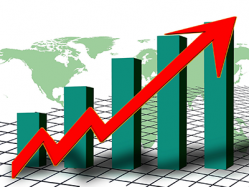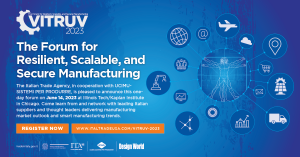THIS INTERNATIONAL ON DEMAND SUMMIT IS AN INDUSTRY EVENT… More
State of the Industry Report 2017: Italian ceramic tile industry continues its growth
The new 2017 financial statement data for the Acimac sample of world ceramic tile manufacturers analysed by the Acimac Research Department reveal a further improvement in Italy’s performance with respect to its international competitors, including growth in both production efficiency and profitability. However, sales growth slowed with respect to the exceptional results of 2016. The improvement in Italian companies’ results is particularly significant compared to those of the non-Italian companies in the Acimac world sample. (This sub-sample, referred to here as “Foreign manufacturers”, includes particularly large numbers of ceramic tile manufacturers from Eastern Europe and Asia, although there are also many companies from Western Europe).
The slower pace of turnover growth is clearly evident in Chart 1, which shows the percentage of Italian and non-Italian companies that have reported growth in turnover. Amongst Italian companies this percentage has fallen sharply to 53% compared to the more than 80% of the boom year 2016, although it remains significantly higher than the figure for foreign companies (40% compared to 60% the previous year). The chart also shows the percentage of companies posting a profit in 2017. The figure for Italian companies is 45% (compared to 85% in 2016), slightly higher than the 44% of their foreign counterparts.
Finally, the Italian ceramic tile manufacturers saw an almost two percentage point improvement in equity ratio with respect to the three-year period 2015-2017. In other words, companies with a growing equity ratio have had a more significant overall impact on the sector than those that have continued to exploit the financial leverage effect by deploying third-party capital in the absence of significant growth in interest rates.
Finally, the Italian ceramic tile manufacturers saw an almost two percentage point improvement in equity ratio with respect to the three-year period 2015-2017. In other words, companies with a growing equity ratio have had a more significant overall impact on the sector than those that have continued to exploit the financial leverage effect by deploying third-party capital in the absence of significant growth in interest rates.
Investments, synergy with machinery manufacturers and technological leadership make Italian ceramic tiles increasingly competitive
In 2017, the Italian ceramic tile manufacturers stepped up their investment spending in both industrial fixed assets and inventory (by 7% and 1.5%, respectively), a trend reversal with respect to 2016. However, the pace of workforce restructuring processes continued to slow. By contrast, companies in the rest of the world saw a widespread fall in investment in all capital goods components.
At the same time, Italian companies maintained a high degree of installed equipment usage compared to the rest of the world (average Italian Asset Turnover Rate or ATR of 0.85 compared to the 0.77 of foreign manufacturers), reflecting a slightly greater efficiency in the use of invested capital. However, the presence of accumulated inventory suggests that Italian companies are still far short of full usage of installed production capacity.
Following the huge investments made during the last few years, in 2017 the Italian ceramic tile manufacturers saw a continued increase in productivity per employee when operating at full capacity. Last year, productivity per employee (added value/employee) grew by around 2,000 euros (approximately the same figure as the increase in labour cost per employee). This contrasts with stagnant levels of productivity per employee amongst other world producer companies. In terms of this competitive factor Italy not only keeps pace with other western manufacturers but is also not excessively outperformed by Asian producers. However, due to the growing technological maturity of many world producers (especially those from Eastern Europe) coupled with lower labour costs, foreign manufacturers enjoy a continued profitability advantage of around half a percentage point in terms of ROI, just above a percentage point in terms of ROS and between 3 and 4 points in terms of EBITDA. However, this advantage falls to just half a percentage point in terms of net profits.
In the final analysis, Italian competitiveness is guaranteed by the high level of technology investments per employee (the highest of all world producers). In turn these investments are driven by the cluster-based economies of proximity and the continuous two-way technology transfer between the ceramic machinery industry and the tile sector.
In addition to these factors relating to production process technology and costs, it should also be remembered that Italian competitiveness partly derives from the industry’s positioning in the highest world segments in terms of design and quality. Italian tiles are only marginally competitive in standard-quality mass consumer segments such as the Asian markets, where labour costs are still sufficiently low to guarantee very high profit margins, but they remain extremely competitive in high quality/high price segments where they are less exposed to competition from Eastern European and Asian manufacturers.
Related Articles:

Source:
Recent News

























